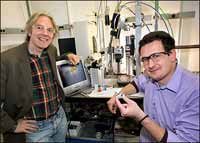Structural distortions emerge from nothing at the nanoscale
29 Dec 2010
Scientists have discovered that a class of materials known to convert heat to electricity and vice versa behaves quite unexpectedly at the nanoscale in response to changes in temperature. The discovery - described in the December 17, 2010, issue of Science - is a new ''opposite-direction'' phase transition that helps explain the strong thermoelectric response of these materials.
 |
| Simon Billinge (left) and Emil Bozin (right) at beamline X17A at the National Synchrotron Light Source (NSLS) at Brookhaven Lab, where the scientists will continue their explorations of local atomic structure to identify materials useful for energy applications. |
It may also help scientists identify other useful thermoelectrics, and could further their application in capturing energy lost as heat, for example, in automotive and factory exhaust.
The scientists - from the US Department of Energy's (DOE) Brookhaven National Laboratory, Columbia University, Argonne National Laboratory, Los Alamos National Laboratory, Northwestern University, and the Swiss Federal Institute of Technology - were studying lead chalcogenides (lead paired with tellurium, selenium, or sulfur) using newly available experimental techniques and theoretical approaches that allow them to ''see'' and model behavior of individual atoms at the nanoscale, or on the order of billionths of a meter. With those tools they were able to observe subtle changes in atomic arrangements invisible to conventional probes of structure.
To understand the phase transition the scientists observed, think of the everyday response of a gas like steam cooling to form liquid water, and then freezing to form solid ice.
In each case, the atoms undergo some form of structural rearrangement, explains Simon Billinge, a physicist at Brookhaven Lab and Columbia University's School of Engineering and Applied Science and a lead author on the Science paper.
''Sometimes, further cooling will lead to further structural transitions: Atoms in the crystal rearrange or become displaced to lower the overall symmetry,'' Billinge says. The development of such localised atomic distortions upon cooling is normal, he says. ''What we discovered in lead chalcogenides is the opposite behavior: At the very lowest temperature, there were no atomic displacements, nothing - but on warming, displacements appear!''






























